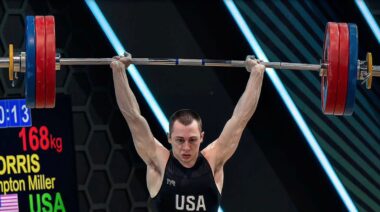In the sport of kings, the ultimate prize for a horse, jockey, trainer, or owner is the Triple Crown, composed of the Kentucky Derby, the Preakness Stakes, and the Belmont Stakes. Many horses win the first two, but only a small number of super horses have won all three, due to the grueling nature of the Belmont.
In the sport of kings, the ultimate prize for a horse, jockey, trainer, or owner is the Triple Crown, composed of the Kentucky Derby, the Preakness Stakes, and the Belmont Stakes. Many horses win the first two, but only a small number of super horses have won all three, due to the grueling nature of the Belmont.
I like to think my sport of weightlifting also has a “Triple Crown.” My trifecta is also difficult since a lifter has to win a world or Olympic championship in three different body weight categories.
RELATED: Choosing the Best Weight Class For Lifting
The First Triple Crown: Stan Stanczyk
So far only three lifters have accomplished this feat, the latest only a few weeks ago in the Senior World Weightlifting Championships in Kazakhstan.
With this year coming to a close, it is probably a good time to reflect on the most significant event occurring there (save perhaps Tatiana Kashirina’s 193kg clean and jerk).
I’m referring to the victory by Ilya Ilyin in the 105kg category. This victory lands Ilya in Triple Crown fame. Three men have done this feat, while several more might have done it in different circumstances. Still, not very many.
“It is virtually impossible to obtain a high international ranking in a low bodyweight category and then maintain it over multiple weight increases.”
The first man to ever perform this feat was Stan Stanczyk of Detroit, Michigan. He won the 67.5kg category in the 1946 Worlds. In 1947, he won the 75kg category, and then the 82.5kg in the 1948 Olympics. What makes this such an unusual feat?
There is nothing unusual about weightlifters moving up in body weight and achieving championships at those different weights. It is common for this to happen in local weightlifting circles.
It is not even unheard of to see a pubescent boy start his career in the lightest category and grow all the way the super heavyweight in maturity. Such lifters may end up growing one body weight category per year.
RELATED: The Difference Between Age and Maturation in Youth Weightlifters
What is unusual is doing this at a high level of competition. It is virtually impossible to obtain a high international ranking in a low bodyweight category and then maintain it over multiple weight increases.
Lifters, just like everyone else, grow up first before they grow out. This often means the growing young athlete is chronically underweight during the early years of his career. It is difficult to win at elite levels in those conditions.
Eventually the athlete and his weight gain slow down, and he arrives at his ideal weight category where he remains for his career.
“Further complicating the issue is the fact that many lifters in these categories were still growing while their competition may have peaked out.”
But back to “Suntan Stan,” as he was known. Why was his Triple Crown significant? Because he did it in the toughest three-category interval in the sport.
Some athletes have set records or won major titles in the 52, 56, and 60kg categories (or their modern equivalents). Such a feat is a bit easier than Stanczyk’s due to the fact the amount of weight to be gained would be less in these lighter categories.
RELATED: How Much Overhead Are You Carrying?
Further complicating the issue is the fact that many lifters in these categories were still growing while their competition may have peaked out.
This may make it slightly easier to win one or two titles at a light weight before moving to a higher category and winning at a more natural bodyweight.
Naim Suleymanoglu of Bulgaria and Turkey seems to have done just that. He clobbered the records in all three categories, at both junior and senior age groups, but only had to gain 8kg to do it all.
In contrast, Stanczyk went from 67.5 to 82.5, a full 15kg. Not only that, but he was competing against mature men in most all cases, men who had no more growing to do.
It is hard enough to win the 67.5s. Competition is stiff there as smaller men take advantage of weightlifting’s opportunity for people of their stature to compete on an even basis.
Moving up to the 75s, you’ll find a lot of lifters who have won adjacent categories. This is not too unusual. But take that same recently grown lifter and feed him some more. Once in the 82.5s the likelihood of him remaining on top is much less. But Stanczyk thrived there.
RELATED: The History of Weight Sports: How They Evolved Since 1900
As an aside, Stanczyk was famous for one incident still remembered nearly seventy years later. In the 1947 US Senior Nationals, Stan had snatched 250 pounds on his second attempt and then decided to go for a world-record 280 on his third. This big a jump is unheard of today and it was even more unheard of in 1947.
Stan gave the weight a mighty pull, locked it out, then rose with the weight and was given the down signal and three white lights. However, unnoticed by the referees Stanczyk had felt his own knee touch the platform at the bottom of his split.
As this is not allowed, many lifters would keep their mouths shut and let the referees’ bad decision prevail. But Stan was made of sterner stuff. He did not want to take credit for a world record not made according to the rules.
“Because of this often-regaled incident, Stanczyk was perhaps better known for this unsuccessful lift than any of the many world records he did set.”
He went over to the referees and told them he had touched his knee, whereby it was incumbent upon the referees to change their decision.
Upon learning what the commotion was about, the crowd gave Stanczyk a standing ovation for his display of sportsmanship. Because of this often-regaled incident, Stanczyk was perhaps better known for this unsuccessful lift than any of the many world records he did set.
Even more unusual about Stan’s triple was that it was accomplished in consecutive years. He did not have a long period of time to slowly increase his body weight. He had to gain 7.5kg each for two consecutive years, after starting from a fairly low body weight. A truly outstanding feat.
Tommy Kono and Other Honorable Mentions
Stan’s teammate Tommy Kono, of Hawaii, would duplicate this feat in 1952-54 in the same weight categories. Some think Kono surpassed Stanczyk, since Kono was also able to set a world record in the 90kg category, weighing only 83 kg. But Stan did the Triple first.
Tommy Kono
Several other lifters have set world records in three categories, but did not win world championships in three.
The great David Rigert (URS) set records in the 82.5, 90, and 100kg categories, while his successor Yuri Zacharivitch (URS) did it at 90, 100, and 110kg. Yuri Vardanyan (URS) also had various world records at 75, 82.5, and 90kg.
Going back to Stanczyk’s day there were two USA lifters who might have done the Triple Crown if the appropriate categories existed at the time.
John Davis won the 82.5s and the 82.5-plus, while Norbert Schemansky won the 90 and 90-plus. If the 90, 100, and 110 categories existed then, it is almost a certainty both would have achieved the elusive hat trick.
RELATED: Cutting Weight in Weightlifting: Is There a Better Way?
With the names and body weights mentioned in the last couple of paragraphs, the reader should get a hint as to why Stanczyk’s feet was greater than anything the heavier men did.
Even though their weight jumps are higher, they are easier to gain while the effect on the total is less than at the middle and lighter categories.
During the 1980s and 90s the world record totals of the 82.5 all the way to the 110 kg categories were not that far apart. It was therefore much easier for somebody to gain 10 kg and do world records if not world titles.
Ilya Ilyin
The Modern Age: Ilya Ilyin
This now brings us back to the modern age of Ilya Ilyin and his Triple Crown. He has now won the 85s, the 94s, and the 105s.
Not as impressive as Stanczyk or Kono, but note that he still holds world records in youth, junior, and senior age categories. Still a truly a fantastic performer.
RELATED: An Analysis of Interesting Weightlifting Records and Trends
Weighing 105 at 175cm, Ilyin is now at his ideal bodyweight.
He was the same height at 85 and 94, so he was a bit on the rangy side then. To still be able to win world titles and set world records under those circumstances was truly amazing. Now all we have to do is wonder what he’s going to do in the future. Will he become the greatest lifter of all time?
He just might. Secretariat anyone?
Photo by ChelseaFunNumberOne (Own work) [CC BY-SA 4.0], via Wikimedia Commons.






